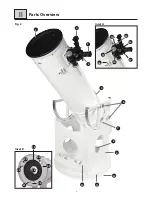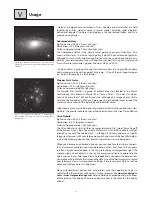
- 2 -
SUN WARNING
DO NOT use this telescope or any accompanying
finder scope to look at or near the Sun! Even
momentary visual contact with the Sun’s light rays
can instantly cause irreversible damage to your
eye(s). Eye damage can be painless, so there is no
warning to the observer that damage has occurred
until it is too late.
Take extra care when using the telescope or a finder
scope during daylight hours, and do not point either
at or near the Sun. Do not look through either when
you are moving the instruments during the daytime.
Never allow anyone to use the telescope or a
finder scope during the daytime without warning
them of the hazards of aiming either at or near the
Sun. Make sure that they are adequately trained
on the use of these instruments before allowing
them to start observing. Children should always
have informed and trained adult supervision while
observing.
PROPER CARE WARNING
Your telescope is a precision optical device and
keeping the optics free of dust and dirt is crucial for
optimal performance. However, the use of improper
cleaning techniques, tools and/or solutions can
cause irreparable damage to your telescope.
In terms of solutions, use distilled water and/or
an optical glass cleaner that can be found at most
camera stores.
Only use pure cotton swabs/balls or white,
unscented, lotion-free tissues for wiping down
optics after you have removed as many particles as
possible with forced air or a photographic-grade
camel hair brush. DO NOT use optical lens cleaning
tissues as many contain fiberglass particles that can
be abrasive.
GENERAL WARNINGS:
• Children should only use this device under adult
supervision.
• Keep all packing materials (plastic bags, etc) out of
the reach of children. These materials present a risk
of SUFFOCATION or CHOKING!
• Do not allow direct sunlight to pass through the
lenses onto an object. The concentration of light
rays could cause burns or start a fire.
• Do not disassemble this device. In the event of
a defect, please contact the Customer Service
Department.
• Do not expose this device to temperatures
exceeding 60°C (140°F).
• Battery guidelines: The red dot viewfinder contains
electronic components that are powered by
batteries. Batteries should be kept out of children’s
reach. When inserting batteries, please ensure the
polarity is correct. Insert the batteries according to
the dis/- information. Never mix old and
new batteries. Replace all batteries at the same
time. Never mix alkaline, standard carbon-zinc and
rechargeable nickel-cadmium batteries. Never
short circuit the device or batteries or throw either
into a fire. Leaking or damaged batteries can cause
injury if they come into contact with the skin. If you
need to handle such batteries, please wear suitable
safety gloves. Remove batteries from the product
before extended storage to prevent leaking. Do not
immerse the battery compartment in water.
!
General Safety Information
Summary of Contents for Explore FirstLight 10" f/5 Dobsonian
Page 19: ...19...






















